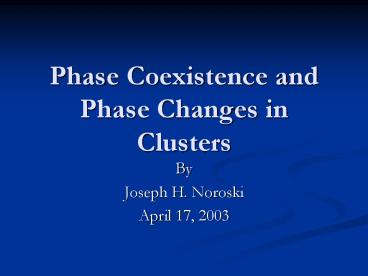Phase Coexistence and Phase Changes in Clusters - PowerPoint PPT Presentation
1 / 15
Title:
Phase Coexistence and Phase Changes in Clusters
Description:
Solid: Particles exist in well-defined sites, oscillating around their ... The potential well is deep and steep, yielding a low density of states. ... – PowerPoint PPT presentation
Number of Views:206
Avg rating:3.0/5.0
Title: Phase Coexistence and Phase Changes in Clusters
1
Phase Coexistence and Phase Changes in Clusters
- By
- Joseph H. Noroski
- April 17, 2003
2
Two Common Phases
- Solid Particles exist in well-defined sites,
oscillating around their equilibrium positions in
small amplitude motions. The potential well is
deep and steep, yielding a low density of states. - Liquid Particles exhibit diffusive motion with
large mean square displacements, have soft
vibrational modes, and can permute (exchange
positions) among themselves. The potential wells
are less deep and steep, yielding a high density
of states.
3
The Bulk World
- The freezing point (Tf) and the melting point
(Tm) are identical for a bulk sample a typical
first order transition. - Phase equilibria can be described entirely by
macroscopic thermodynamic variables and, as such,
are STATIC equilibria.
4
The Cluster World
- The freezing and melting points are not the same.
There exists an equilibrium between phases over
a range of T. - Phase equilibria must be considered in dynamic
terms that is, consider ENSEMBLES of clusters. - The individual clusters freely pass from one
phase to another.
5
Other Types of Phases in Clusters
- Surface-melted solid core, liquid surface, and a
few floaters above the surface The surface
becomes liquid-like when about 1 atom in 30
floats above. - Soft solid clusters can pass between a limited
number of solid-like potential minima with
relatively large amplitude motions no permuting
of identical atoms among non-equivalent sites - Slush short duration of various phase-like forms
6
Examining Clusters
- The majority of cluster research is done via
computer simulation. The experimental
difficulties, of course, result from synthesizing
something with 10 1000 atoms in a reproducible
way. - Probe atoms inserted into the clusters possess
different spectra in one phase or another. These
spectra are used to identify different phases.
7
Solid-Liquid Equilibrium in Clusters
- There is only one minimum in the potential well
below Tf and only one minimum above Tm. - For clusters there exists a RANGE of T (at a
single pressure) for which the equilibrium (s) ?
(l) exists. So, Keq liq/sol
exp(-?F/kBT). ?F is the free energy difference
in the minima for the solid and liquid.
8
Conditions for Coexistence
- S-bends in the probability distributions of, for
example, the canonical ensemble, P(E), or the
grand canonical ensemble, P(N). - For example, an S-bend in the microcanonical
caloric curve results when ln P(E) for the
corresponding canonical distribution has two
inflections.
9
A Triple Point is Now a Triple Range????
- The Gibbs Phase rule says that three phases of
one component can exist at only one T, the
so-called triple point, T3. - Simulations show that surface-melted clusters can
coexist with solid and liquid clusters over a
range of T. - For clusters each phase is as much a component as
it is a phase. - The Gibbs Phase rule has no meaning for ensembles
of small systems.
10
More on Solid/Liquid/Surface-Melted Equilibrium
- The grand canonical partition function is of the
form Zc(mc)Zs(ms)Zf(mf)Zint(mc, ms, mf). c
core s surface f floater int
interaction. mxs are defects. For example, ms
are floater-vacancy pairs. - Conditions for coexistence (?ln Zc/?mc)T 0 and
(?ln ZsZf /?mf)T 0. - Number of analytical solutions indicates the
number of phases present. - New types of phase diagrams are needed.
11
A Model for Phase Changes
- Vekhter and Berry used simulations to examine
Ar55 and (KCl)32 clusters. - Over a T range of 730-760 K two phases observed
for KCl crystal-like and liquid-like. Over a T
range near 40 K three phases observed for Ar55
solid, liquid, and surface-melted. - The third phase of Ar55 is due to a third peak in
the density of states not present for (KCl)32.
12
A Model for Phase Changes (cont.)
- We can explain (KCl)32 by a two-level model with
a nondegenerate ground state (where the solid
is) and an N1-fold degenerate excited state
(where the amorphous liquid states are). The
difference in energy is d. - The population of the excited level is n1(T)
N1exp(-d/kT)/1 N1exp(-d/kT). It is key to
note that, as N1 grows, the solid to liquid
transition temperature range gets smaller.
13
A Model for Phase Changes (cont.)
- Ar55 requires an intermediate energy level, dsm.
- s solid m surface-melted l liquid
- Two consecutive transitions, (s) to (m), followed
by (m) to (l), occur if Tsl Tsm, where kBTsm
dsm/ln(Nsm) and kBTsl (d1 - dsm) /ln(N1/Nsm). - If Tsm Tsl, no surface-melted phase seen.
- If Tsm Tsl, 3 phase coexistence is seen.
14
Other efforts with clusters
- Nigra, et. al. have used parallel tempering Monte
Carlo and multihistogram methods to study phase
changes of (H2O)8. - There is a sharp Tm at 178.5 K.
- However, a solid to solid phase change is found
at 12 K. Here, the (H2O)8 clusters change
symmetry from strictly D2d to a mixture of D2d
and S4. - Others cluster research involves efforts to store
data in condensed form using small clusters.
15
References
- R. S. Berry, in Large Clusters of Atoms and
Molecules, edited by T.P. Martin (Kluwer,
Dordrecht, 1996), p. 281. - R. S. Berry, in Scientific American, (August,
1990), p. 68. - P. Nigra, M. A. Carignano, and S. Kais, J. Chem.
Phys. 115, 2621 (2001). - Benjamin Vekhter and R. S. Berry, J. Chem. Phys.,
106, 6456 (1997).































